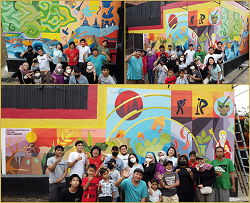Revitalisasi Dinding Melalui Pembuatan Mural dengan Narasi Sejarah Jamblang, Cirebon Wall Revitalization Through Making Murals with Jamblang History Narrative, Cirebon
Main Article Content
Abstract
Jamblang Chinatown, Cirebon was once known as a trading city during the Dutch colonial period, as a place for buying and selling and stopping by traders from various regions through the river that flows nearby. The river is a means of transportation that brings ships from the interior of Cirebon to the Java Sea, and vice versa. However, the current situation is reversed because Jamblang is like a "dead city" that is almost forgotten. The government and the community have a dream to revive the Jamblang Chinatown area. Through this PKM activity, a team of lecturers and students of the Faculty of Fine Arts and Design at Maranatha Christian University seeks to revive Jamblang Chinatown by making murals with the surrounding community, as well as providing education as well as performances for the surrounding community through PKM activities. The attraction of making murals containing the historical value of Jamblang. The approach taken is a participatory collaborative workshop with local residents, through mentoring and education. The result achieved is a mural with the theme Mural History Jamblang, which is located on a 90-degree wall and is located in front of Vihara Dharma Rhakita, Jamblang, Cirebon Regency. They participate in the process of making murals. Other residents are interested in knowing the meaning contained in the visualization of the mural. And many are just selfies with a mural as a background. This mural-making attraction is also quite successful as one of the activities that attract public attention during the 2022 Jamblang Festival.
Downloads
Article Details

This work is licensed under a Creative Commons Attribution-ShareAlike 4.0 International License.
Authors who publish with this journal agree to the following terms:
- Any article on the copyright is retained by the author(s).
- Author grant the journal, right of first publication with the work simultaneously licensed under a Creative Commons Attribution License that allows others to share work with acknowledgment of the work authors and initial publications in this journal.
- Authors are able to enter into a separate, additional contractual arrangements for non-exclusive distribution of published articles of work (eg, post-institutional repository) or publish it in a book, with acknowledgment of its initial publication in this journal.
- Authors are permitted and encouraged to post their work online (e.g., in institutional repositories or on their websites) prior to and during the submission process, as can lead to productive exchanges, as well as earlier and greater citation of published work.
- The article and any associated published material is distributed under the Creative Commons Attribution-ShareAlike 4.0 International License
References
Adi, S. P., Sumargo, A., & Putra, S. B. S. (2017). Perkembangan Seni Urban di Surakarta. 1st ed. Surakarta: Dwi-Quantum.
Aryanti, S. Z., Nasucha, Y., & Ma’ruf, A. I. (2020). Mural Art Media for Millennials Character Education. JMM (Jurnal Masyarakat Mandiri), 4(3), 7–8. https://doi.org/10.31764/jmm.v4i3.2497
Bobby, G. (2022). Sultan Sepuh XV Keraton Kasepuhan Cirebon Berharap Wisatawan Traveling Ke Kota Tua Jamblang. http://patadaily.id/2022/07/19/sultan-sepuh-xv-keraton-kasepuhan-cirebon-berharap-wisatawan-traveling-ke-kota-tua-jamblang/
Dharsono, S. K. (2004). Seni Rupa Modern. Cetakan I. Bandung: Rekayasa Sains.
Gazali, M. (2017). Seni Mural Ruang Publik Dalam Konteks Konservasi. Imajinasi : Jurnal Seni, 11(1), 69–76. https://doi.org/10.15294/imajinasi.v11i1.11190
Guntoro. (2020). Membangun Komunikasi Yang Ideal Di Ruang Publik. Jurnal Ilmu Komunikasi PROGRESSIO, 1(1), 1-12. http://dx.doi.org/10.52429/progressio.v1i1.382
Gushendra, R. P. (2017). The Role of Graffiti and Mural As Alternative Public Sphere for Society. PEOPLE: International Journal of Social Sciences, 1(1), 746–753. https://doi.org/10.20319/pijss.2015.s21.746753
Irwandi, E. & Sabana. 2019. Proses Perwujudan Identitas Tempat Melalui Seni Mural. Prosiding Seminar Nasional Desain dan Arsitektur (SENADA), 2, 70–76.
Kemal, M. (2022). Festival Jamblang 2022, Suguhkan Mural Sejarah Jamblang. https://ciayumajakuning.pikiran-rakyat.com/cirebon/pr-2575036679/festival-jamblang-2022-suguhkan-mural-sejarah-jamblang
Laal, M. & Ghodisi, S. M. (2012). Benefits of Collaborative Learning. Procedia Social and Behavioral Sciences, 31, 486-490. https://doi.org/10.1016/j.sbspro.2011.12.091
Mandušić, D. & Blašković, L. (2015). The Impact of Collaborative Learning to Critically Thinking. Trakia Journal of Sciences, 13(Suppl.1.), 426–428. http://dx.doi.org/10.15547/tjs.2015.s.01.073
Mendelson-Shwartz, E. & Mualam, N. (2021). Taming Murals in the City: A Foray into Mural Policies, Practices, and Regulation. International Journal of Cultural Policy, 27(1), 65–86. https://doi.org/10.1080/10286632.2020.1722115
Nurkukuh, D. K. (2018). Peran Mural Dalam Pembentukan Sense of Place Kampung Code Yogyakarta. Kurvatek : Journal Technology of Civic, Electrical, Mechanical, Geology, Minning and Urban Design, 3(2), 1–5. https://doi.org/10.33579/krvtk.v3i2.739
Pandanwangi, A., Ida, Ratnadewi, Manurung, R. T., Budiman, I., & Vincent. (2021). Tingkat Kebahagiaan Masyarakat Setelah Adanya Mural Di Kelurahan Sukawarna Kecamatan Sukajadi Bandung. Ideas: Jurnal Pendidikan, Sosial, dan Budaya, 7(2), 137–50. https://doi.org/10.32884/ideas.v7i2.365
Rusyanti. (2016). Rekonstruksi Sejarah Pecinan Jamblang Kabupaten Cirebon Berdasarkan Data Arkeologis Dan Catatan Berhuruf Tionghoa Pada Dinding Klenteng Hok Tek Ceng Sin. Purbawidya : Jurnal Penelitian dan Pengembangan Arkeologi, 1(1), 91–108. https://doi.org/10.24164/pw.v1i1.12
